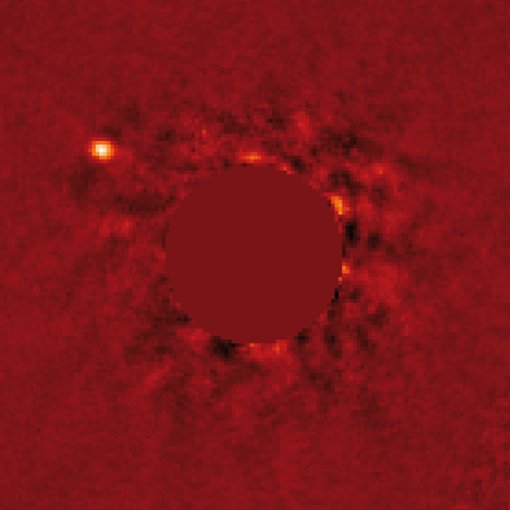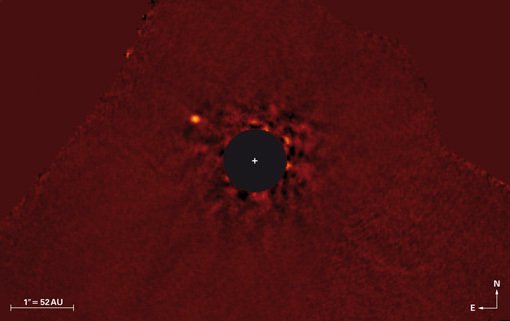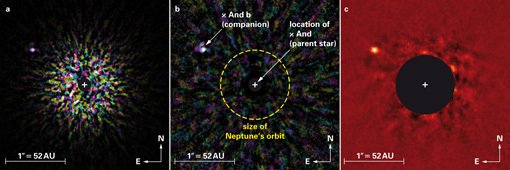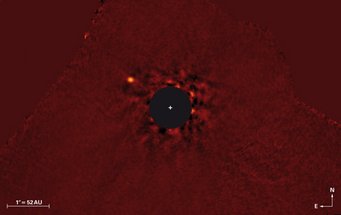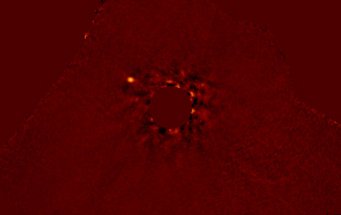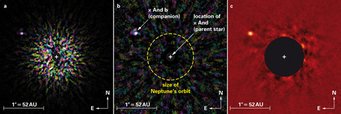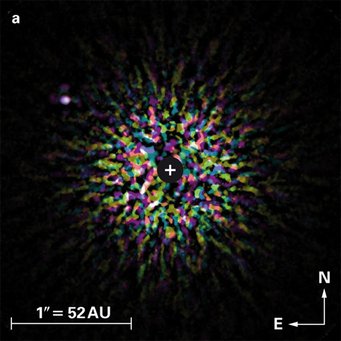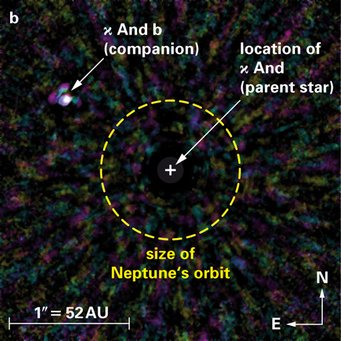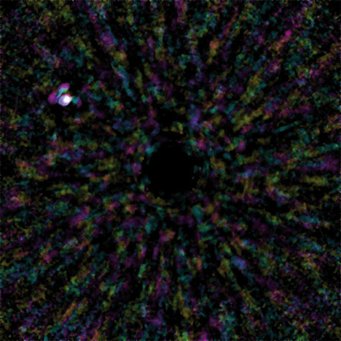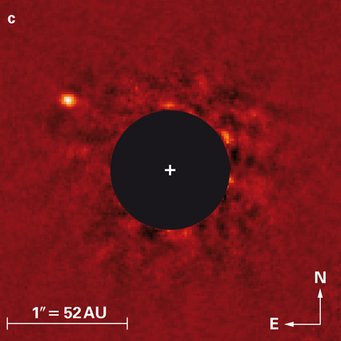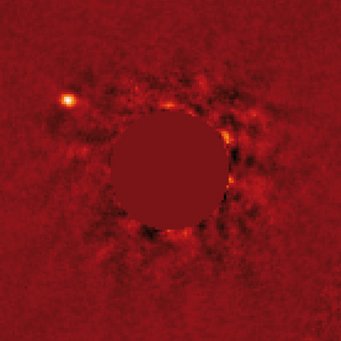Rare image of Super-Jupiter sheds light on planet formation
An infrared imaging search with the Subaru telescope has captured a rare image of a "Super-Jupiter" around the massive star κ Andromedae. The gas giant has a mass about 13 times that of Jupiter, while the host star has a mass 2.5 times that of the Sun. There are strong indications that this planet formed in a manner similar to ordinary, lower-mass exoplanets: in a "protoplanetary disk" of gas and dust that surrounded the newborn star. This makes the planet an important test case for current models of planet formation and their predictions about planets around massive stars.
| Background information | Questions & Answers | Image download |
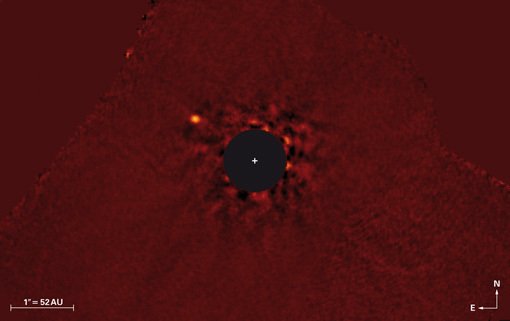
Of the nearly 850 exoplanets – planets orbiting stars other than the Sun –currently known, only a minute fraction have been captured in actual astronomical images. The vast majority of detections rely on indirect methods. The reason for this discrepancy: stars are much brighter than their planets (typically by a factor of a billion or more); using traditional observational techniques, the planet will be hidden in the glare of its host star.
Now, a research team led by Joseph Carson (College of Charleston and Max Planck Institute for Astronomy) has managed to obtain an image of a large "Super-Jupiter" around the massive star κ And ("kappa Andromedae"). Their discovery makes use of the Subaru 8-meter telescope on the summit of Mauna Kea in Hawai'i, operated by the National Astronomical Observatory of Japan.
κ And is a very young star, with an estimated age of 30 million years (our Sun, for comparison, is around 5 billion years old). Obtaining an image of its companion κ And b required advanced techniques both for observation and for image analysis. A particular challenge was that the orbit of the newly detected object is only somewhat larger than that of Neptune – most planetary images have been obtained for planets in significantly larger orbits.
With a mass of about 13 times that of Jupiter, the object, called κ And b ("Kappa Andromedae b"), could be either a planet or a very lightweight "brown dwarf", an object that is intermediate between planets and stars. Circumstantial evidence indicates that it is likely to be a planet.
An interesting aspect of the new Super-Jupiter is that it orbits a fairly young star, and at a distance comparable to planetary orbits within our own Solar System. Taken together, this is a strong indication that the planet formed in a manner similar to that of lower mass planets: within a primordial, "protoplanetary" disk of gas and dusk which surrounded the star during its earliest stages. In recent years, observers and theoreticians have argued that large, massive stars like this are more likely to have large planets than smaller stars such as our Sun. Yet there have also been concerns: massive young stars emit enormous amounts of high-energy radiation. This radiation could dissipate parts of the protoplanetary disk, which would in turn disrupt planet formation.
The discovery of the Super-Jupiter κ And b suggests that stars as massive as 2.5 solar masses are still fully capable of producing planets within their primordial circumstellar disks – key information for researchers working on models of planet formation.
A key advantage of direct exoplanet detection is the target's immediate accessibility for follow-up examination by traditional astronomical techniques, such as an in-depth analysis of its light by spectroscopy. This is the aim of ongoing observations of the light emitted by κ And b across a broad range of wavelengths. The ongoing observations will lead to a better understanding of the gas giant's atmospheric chemistry, and yield more precise information about the object's orbit and the possible presence of additional planets. In the end, the astronomers should have a better picture of the Super-Jupiter's genesis, and about planet formation around massive stars in general.
Background information
The discovery was made in the context of the SEEDS project ("Strategic Explorations of Exoplanets and Disks with Subaru"). The observational data was obtained using the HiCIAO high-contrast imaging instrument and the IRCS infrared camera at the Subaru telescope on Mauna Kea, Hawai'i, operated by the National Astronomical Observatory of Japan (NAOJ). The SEEDS survey is led by principal investigator Dr. Motohide Tamura (NAOJ). The lead author of the discovery paper is Dr. Joseph Carson of College of Charleston (CofC) and the Max Planck Institute for Astronomy (MPIA) in Heidelberg, Germany. The local SEEDS Co-PI at the Max Planck Institute for Astronomy is Prof. Dr. Thomas Henning.
The work described here will be published as J. Carson et al., "Direct Imaging Discovery of a 'Super-Jupiter' Around the late B-Type Star Kappa Andromedae" in the Astrophysical Journal Letters.
• Article preprint
The co-authors are J. Carson (College of Charleston [CofC] and Max Planck Institute for Astronomy [MPIA]), C. Thalmann (University of Amsterdam and MPIA), M. Janson (Princeton University), T. Kozakis (CofC), M. Bonnefoy, B. Biller, J. Schlieder (all MPIA), T. Currie, M. McElwain (both Goddard Space Flight Center), M. Goto (Ludwig-Maximilians University, Munich), T. Henning, W. Brandner, M. Feldt (all MPIA), R. Kandori (National Astronomical Observatory of Japan [NAOJ]), M. Kuzuhara (NAOJ and University of Tokyo), L. Stevens, P. Wong, K. Gainey (all CofC), M. Fukagawa, Y. Kuwada (both Osaka University), T. Brandt (Princeton University), J. Kwon (NAOJ), L. Abe (Université de Nice-Sophia Antipolis) , S. Egner (Subaru Telescope), C. Grady (Goddard Space Flight Center), O. Guyon (Subaru Telescope), J. Hashimoto (NAOJ), Y. Hayano11 (Subaru Telescope), M. Hayashi (NAOJ), S. Hayashi (Subaru Telescope), K. Hodapp (University of Hawaii), M. Ishii (Subaru Telescope), M. Iye (NAOJ), G. Knapp (Princeton University), T. Kudo (Subaru Telescope), N. Kusakabe (NAOJ), T. Matsuo (Kyoto University), S. Miyama (Hiroshima University), J. Morino (NAOJ), A. Moro-Martin (Instituto Nacional T´ecnica Aeroespacial, Madrid), T. Nishimura, T. Pyo (both Subaru Telescope), E. Serabyn (Jet Propulsion Laboratory), H. Suto, R. Suzuki (both NAOJ), M. Takami (Academia Sinica, Taiwan), N. Takato, H. Terada, D. Tomono (all NAOJ), E. Turner (Princeton University and University of Tokyo), M. Watanabe (Hokkaido University), J. Wisniewski (University of Oklahoma), T. Yamada (Tohoku University), H. Takami (NAOJ), T. Usuda (Subaru Telescope), and M. Tamura (NAOJ).
Questions and Answers
Where did the star and planet get their names?
For bright stars like κ And, the astronomical naming convention follows that of the German 17th century astronomer Johann Bayer: the second part denotes the constellation (here And = Andromeda), while the first part is a lower-case greek letter that labels the star, usually in order of descending apparent brightness. With "kappa" the tenth letter of the Greek alphabet, κ And is indeed less bright than most (not all) stars designated with preceding Greek letters.
Exoplanets around a star are named in order of discovery with lower-case latin letters appended to the star's name, starting with b. Consequently, the first planet discovered around the star κ And is called κ And b.
What are the basic properties of the κ And system?
κ And is a massive, hot young star (spectral type B9, estimated mass between 2.4 and 2.5 times that of the Sun, effective temperature on the order of 10,000 K) in the constellation Andromeda. Its distance from Earth amounts to about 170 light-years.
κ And b has an estimated mass of around 12.8 times that of Jupiter. Going by this mass alone, the object could either be a large planet or a very lightweight brown dwarf. However, a comparison of κ And b brightness between four different infrared wavelengths revealed infrared colors similar to that of the handful of other gas giant planets successfully imaged around stars. Also, models of planet formation predict the mass of gas giants to increase with the mass of the host star; since the mass of κ And is between 2.4 and 2.5 times that of the Sun, a large planetary mass for a Super-Jupiter is not surprising.
For models of planet formation, it is of minor interest where on the boundary between planets and brown dwarfs κ And b is located, and Carson et al. have defined their term "Super-Jupiter" to include both kinds of objects – as long as the object has formed in the same way as the planets in our own Solar System, namely from a protoplanetary disk around a young star.
κ And b appears to orbit its host star at a distance of at least 55 AU (that is, 55 times the mean distance of the Earth from the Sun; for comparison: Neptune's mean distance from the Sun is 30 AU). However, just as objects can appear foreshortened when viewed at an angle, a planet's apparent distance from its host star, as observed from Earth, will in generally be smaller than the true distance.
κ And is believed to be a member of the Columba stellar moving group – an association of stars that have formed as a group an estimated 30 million years ago, and are still drifting through the galaxy on somewhat similar orbits. Another member of that group is the famous high mass star, HR 8799, which is one of the first star systems where astronomers were able to directly image an extrasolar planet. Although the HR 8799 mass is not nearly as large as that of κ And, the HR 8799 star system hosts several gas giant planets with masses and infrared colors similar to that of κ And b.
How was the image of the planet obtained?
In a single infrared snapshot, the tiny point of light that is κ And b is completely lost amid the overwhelming glare of the host star. The SEEDS observing team was able to distinguish the object's faint light only after using a technique known as angular differential imaging, where a time-series of individual images are combined in a manner that exploits the telescope's changing orientation across longer observations, allowing for the otherwise overwhelming glare of the host star to be removed from the final, combined image. Details about this technique, "angular differential imaging", can be found here: http://www.mpia.de/homes/thalmann/adi.htm
κ And b is one of only 30 planets that astronomers have been able to image directly. The Super-Jupiter was detected in independent observations in January and July 2012 at four different wavelengths. A comparison of relative positions between the two epochs showed that the Super-Jupiter κ And b shows the same slight movement on the night sky as does its host star ("common proper motion", in this case around two hundred-thousandth of a degree per year). This is convincing evidence that the two objects are indeed gravitationally bound.
Young planets retain significant heat from their formation, making them comparatively bright at infrared wavelengths. κ And b has a surface temperature of ~1700 K (about 1400 degrees Celsius). This makes young star systems attractive targets for direct imaging planet searches.
What makes the discovery special?
Given the technical challenges involved in the direct imaging of exoplanets, each new imaging feat is noteworthy in and of itself.
What makes this particular discovery special are the implications for planet formation: κ And is by far the most massive star to exhibit evidence of planet formation in a manner similar to the birth of our own Solar System.
While there are images of planets around host stars with a larger estimated mass, most of these are for stars in a much later stage of development ("post main sequence"), or concern companions orbiting at much greater distances than those in the Solar System. Both are indications that the planets in question have not formed in the same way as our own Solar System, namely from a protoplanetary disk around a young star.
κ And, on the other hand, is a fairly young star, and the distance from the object κ And b to its host star is on the same order as that of Neptune within our own Solar System (30 AU for Neptune vs. 55 AU for κ And b). This indicates that κ And b should indeed have formed from a protoplanetary disk.
Which telescopes and instruments were used for the discovery?
The observations were made with the SUBARU Telescope, the flagship telescope of the National Astronomical Observatory of Japan, a reflecting telescope whose main mirror is 8,2 metres in diameter. »SUBARU« is Japanese for the Pleiades, perhaps the best-known open star cluster.
The instruments – the »astronomical cameras« – used were the IRCS infrared camera and HiCIAO, the »High-Contrast Coronagraphic Imager for Adaptive Optics«. HiCIAO is especially designed for the observations of faint objects near stars, such as exoplanets and protoplanetary disks. It uses state-of-the-art adaptive optics, a technique that can compensate for the disturbances caused as a distant stars' light passes through the Earth's atmosphere (the »twinkling« of stars), and it physically blocks out part of the stars' light (»coronagraph«) to enable imaging of the much fainter objects next to it.
In late 2009, HiCIAO produced the first image of an ultracool (»planet-like«) brown dwarf companion around a Sun-like star (cf. this MPIA press release). In early 2011, it imaged a planetary system in the making, imaging a protoplanetary disk in unprecedented detail (cf. this MPIA press release).
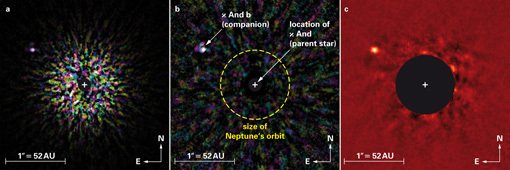
Linke Abbildung: Aufnahme im Nahinfrarotlicht (Wellenlängen 1,2 bis 2,4 Mikrometer).
Mittlere Abbildung: »Signal-zu-Rauschen«-Karte für die Abbildung links. Je weißer ein Fleck, desto höher ist die Wahrscheinlichkeit, dass es sich nicht um einen zufälligen Störeffekt (»Rauschen«) handelt, sondern dass dort tatsächlich ein Himmelskörper zu sehen ist (»Signal«). Die weiße Farbe des Super-Jupiter-Fleckchens oben links zeigt, dass es sich mit sehr großer Wahrscheinlichkeit um einen tatsächlichen Nachweis handelt.
Rechte Abbildung: Aufnahme im Nahinfrarotlicht (Wellenlänge 3,8 Mikrometer)
Download area
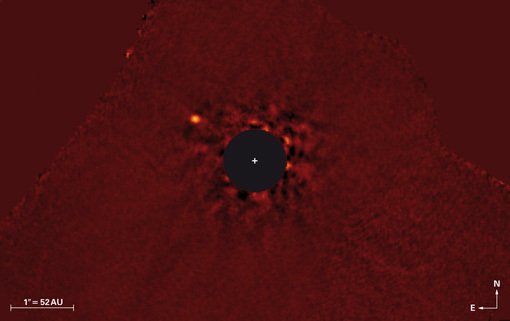
Mit Beschriftung
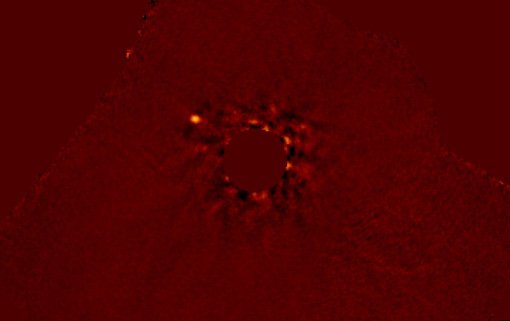
Ohne Beschriftung
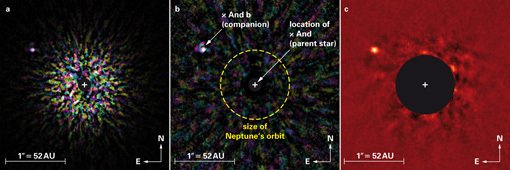
Linke Abbildung: Aufnahme im Nahinfrarotlicht (Wellenlängen 1,2 bis 2,4 Mikrometer).
Mittlere Abbildung: »Signal-zu-Rauschen«-Karte für die Abbildung links. Je weißer ein Fleck, desto höher ist die Wahrscheinlichkeit, dass es sich nicht um einen zufälligen Störeffekt (»Rauschen«) handelt, sondern dass dort tatsächlich ein Himmelskörper zu sehen ist (»Signal«). Die weiße Farbe des Super-Jupiter-Fleckchens oben links zeigt, dass es sich mit sehr großer Wahrscheinlichkeit um einen tatsächlichen Nachweis handelt.
Rechte Abbildung: Aufnahme im Nahinfrarotlicht (Wellenlänge 3,8 Mikrometer)
Mit Beschriftung

Ohne Beschriftung
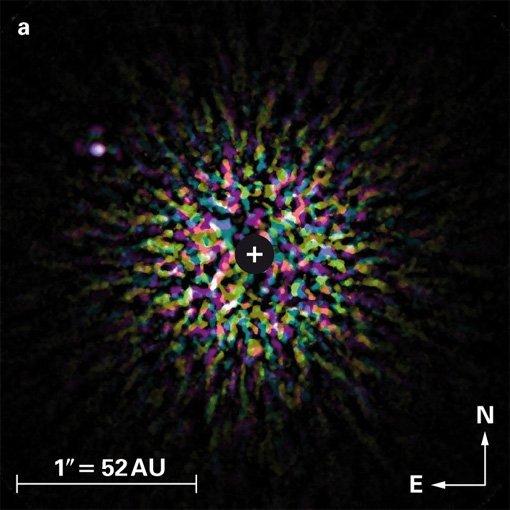
Mit Beschriftung
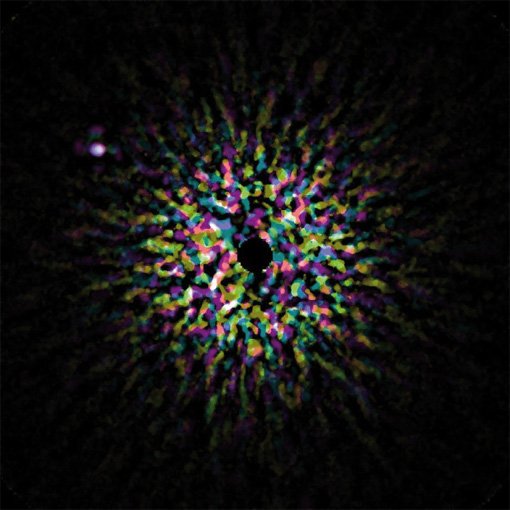
Ohne Beschriftung
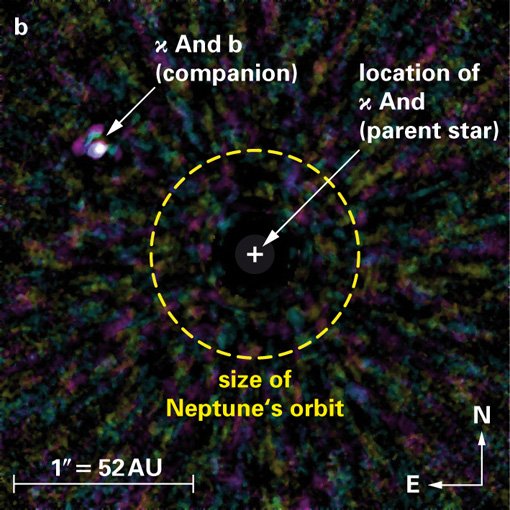
Mit Beschriftung
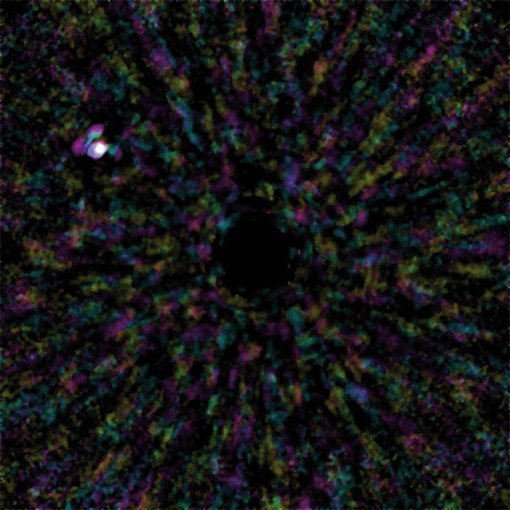
Ohne Beschriftung
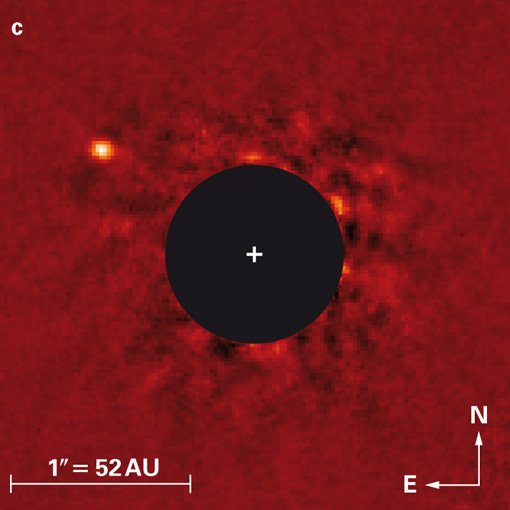
Mit Beschriftung
